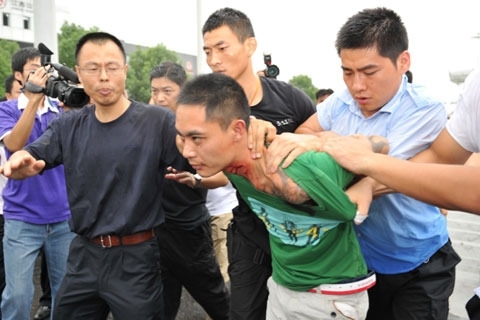


By Chen Jieren (陈杰人) , media commentator and researcher at the China University of Political Science and Law’s Legal News Research Center
Economic Observer Online
Aug 31, 2011
Translated by Zhu Na
Original article: [Chinese]
According to media reports, on Aug 30, four men who were wanted by police in relation to a murder case were travelling on a long-distance bus when it arrived at a toll station on the outskirts of Nanjing at about 1pm. When the police boarded the bus, one of the four men pulled out a knife and took two passengers hostage – a man and his young daughter.
A SWAT team arrived at the scene and after failing to persuade the man to release the two hostages, at about 2.50pm, they fired a shot which missed the hostage taker and struck one of the hostages in the face. Thirty minutes later a sniper had a second attempt at taking out the hostage taker, but the bullet only grazed the man’s neck.
Both the Nanjing police and the Weibo account of the Nanjing government referred to the operation as “a successful rescue of the hostages.” Some official reports also went so far as to claim that no-one was hurt in the operation and others have praised the police for the ‘successful’ rescue.
This was not a successful rescue - it was a failure.
Firstly, the police knew in advance that the suspects were traveling on the bus to Nanjing, but they failed to make adequate preparations. Instead, the toll station was told to stall the coach for 40 minutes on a pretext before police could arrive, which no doubt added tension to the situation.
Secondly, the first shot didn’t hit the hostage taker but the hostage; this is classic sign of a failed rescue attempt. To ensure the safety of the hostages and avoiding provocation of the hijacker is one of the basic requirements of hostage negotiations.
Third, the second shot only scratched the hijacker’s neck and it came 30 minutes after the original shot. From TV footage taken after the hostage taker was arrested, we can see that he was still conscious, if he really wanted to kill the hostage, he would have been able to do so after the gun had been fired. Therefore, the rescue not only failed to ensure the safety of the hostage, but actually severely injured the hostage and didn’t really hurt the hijacker.
About one year ago, a bus load of Hong Kong tourists traveling in the Philippines were taken hostage. During the rescue attempt that followed, some of the hostages were wounded by the stray bullets of the SWAT team sent to rescue them. This incident had severe repercussions for the reputation of the Filipino police and also impacted diplomatic relations between China and the Philippines. This incident reminded all of us of the importance of approaching hostage situations with caution rather than simply rushing in guns ablaze.
The rash actions of the Nanjing police are a good indication of how police around the country have dealt with hostage situations over recent years.
In some places, when police approach a hostage situation, their thinking is too simple. They always try to solve the problem as soon as they can. There are even a few police officers who think it’s a failure if the hostages-takers are not attacked.
This kind of misguided approach is a result of putting the pride of the police ahead of the need to ensure the public’s safety, it’s also a result of a misguided attempt to seek praise from their superiors.
I hope that Chinese police will seriously reflect on the failed Nanjing hostage rescue and examine it from various angles so that they can right their thinking and avoid making similar mistakes in the future.

